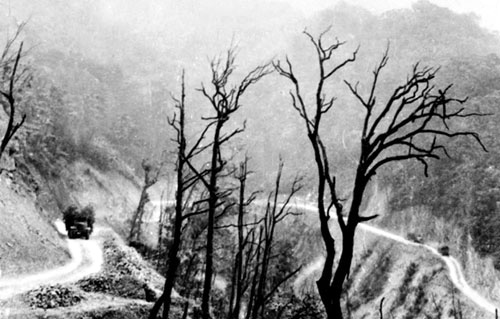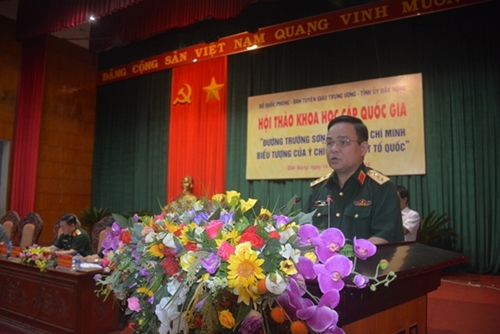This statement was reiterated by senior officials, high-ranking military officers, scholars and Truong Son Army Corps veterans at the national seminar titled “Truong Son - Ho Chi Minh Trail – Symbol of the Strong Will to Reunify the Nation” co-held on May 14 by the Ministry of National Defense, the Central Commission for Information and Education, and the provincial Party Committee of Dak Nong.
The organizers received nearly 80 reports, of which nine were presented at the seminar, highlighting the significance, position and success of the organization of the trail in reaching the ultimate goal of national reunification. The reports also analyzed major methods of transport employed during wartime and clarified the role of the trail in promoting relations among the three countries of Vietnam, Laos, and Cambodia.
    |
 |
|
Truong Son - Ho Chi Minh Trail in the past. Source: File photo |
Creative and unique decision of the Party
Senior Lieutenant General Le Chiem, Deputy Defense Minister, opened the seminar by stressing that, “In 16 years, officials and troops of Truong Son Army Corps and volunteer youths, conscripted laborers, and people in localities where the trail ran through upheld the resolve of ‘fighting the enemy and opening roads to advance southward.’ Overcoming countless hardships, they defeated all destructive operations of the enemy to build, organize, and protect the strategic supply trail to transport personnel and materials from the home-front of the North to the forefront in the South.”
The Truong Son – Ho Chi Minh Trail really became the focal point of the national synergy, showing the strong will, firm resolve and confidence of the nation to gain the final victory of the war of resistance. The legendary trail has gone down in the history of the nation as a miracle and an exploit of the whole nation in the cause of South liberation and national reunification.
    |
 |
|
Senior Lieutenant General Le Chiem speaking at the conference |
In his introductory speech, Senior Lieutenant General Nguyen Trong Nghia, Deputy Chief of the General Department of Politics of the Vietnam People’s Army, affirmed that the establishment of the Truong Son – Ho Chi Minh Trail helped realize the determination of “All for the beloved South, all for defeating the US invaders” of the armed forces and people of the whole country. The vital transport and communication system not only served to transport military supplies, but also was a theater of combined-arms battles, a fierce struggle between the Vietnamese revolutionary troops and the enemy, and a rendezvous of power, belief and resolve to unyieldingly fight for national independence, freedom, peace and national reunification. It is also a vivid symbol of solidarity among the peoples of Vietnam, Laos and Cambodia.
All presentations at the seminar affirmed that the Truong Son - Ho Chi Minh Trail is strategically important and holds great significance while showing the creativity in the art of force organization and a new step forward in the development of the war direction and operation of the Party. The strategic trail was a big theater for forces to engage in combined-arms operations. The forces operated along the trail included transport, infantry, engineering, artillery, air defense, signal, medical troops, volunteer youths, conscripted laborers, and more, transporting seamlessly millions of tons of materials and tens of thousands of people to the forefront. The opening of the Truong Son - Ho Chi Minh Trail is the creative and unique decision of the Party.
Important factor contributing to the final victory
During the war of resistance, it is demanded that both material and human resources be mobilized to assist the South. On that reality, the Truong Son - Ho Chi Minh Trail was established, gradually extended and expanded during the war, contributing significantly to the final victory of the resistance war and reunification of the nation.
After the establishment of Unit 559 (fore-runner of Truong Son Army Corps), in early 1960s, the enemy learned that supplies were transported to the South along the trail. They opened raids, sometimes lasting for six months with the engagement of up to six battalions. To deal with enemy operations, the Vietnamese forces opened various routes of the trail in the Western Truong Son (Anamese) Range. Major General Nguyen Ba Tong, hero of the people’s armed forces and former Second-in-Command Officer in charge of political affairs of Army Corps 12 (successor of Truong Son Army Corps), recalled those fierce and heroic days, “We regularly faced dangers from US mines and magnetic and timed bombs. US air raids using AC-130 aircraft caused great losses to our forces along the trail. The number of those killed in action alone amounted to 12,000 people.”
Despite those hardships and great sacrifices, troops, volunteer youths, conscripted laborers of Truong Son Army Corps always ensured the smooth transport of material supplies and troops and communication between the North and the South. The legendary trail contributed strategically to the final victory of the resistance war.
All presentations and reports sent to the seminar share the same view: The Truong Son - Ho Chi Minh Trail still serves as an important route in the current construction and development cause of the nation in all aspects of culture, economy, society, security, and defense. The Truong Son Road, built on the basis of the Ho Chi Minh Trail, has been now upgraded and expanded, attracting a lot of domestic and foreign visitors. The legendary trail is also a good historical lesson to educate today’s generation about the glorious tradition and patriotism of their grandfathers’ and fathers’ generations.
Closing the event, Senior Lieutenant General Le Chiem stressed that with the high sense of responsibility of all participants, the seminar concluded successfully, meeting the set targets, providing the public with abundant and quality information and evidence of the legendary and historic trail in the history of the Vietnamese people.
Translated by Huu Duong